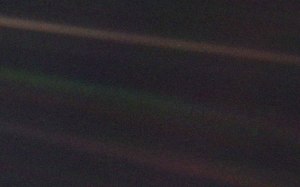Although we talked about the scale of the Sun, the galaxy, and the rest of the universe, it didn’t really hit me until the end of the semester just how gigantic the scale is. Sure, it helped to learn that if the Sun were the size of a basketball, the Earth would be about as big as a pea. If the universe was shrunk so that the Sun was the size of a melon and located in California, the next closest star would be located in Washington, D.C. If we think about the size of the universe itself, it’s hard to even comprehend the possible distances. It would take 14 billion years, travelling at the speed of light, to cross the observable universe. And we don’t even know what, if anything, lies beyond that.
Despite all of these scales and comparisons, I did not understand the size of the universe until we talked about Voyager 1 and the Pale Blue Dot. It has taken a spacecraft launched by humans nearly forty years to reach the outer parts of our solar system, but it would still take it a few hundred even reach the Oort Cloud. We can hope that the information sent by our small, insignificant blue dot will be found by other intelligent beings, but the universe is just too big for us to know what is out there.
It can be easy to feel small and insignificant when one considers the size of the entire universe, but the fact that all of us are composed of material created in the explosions of stars is also empowering. If the universe has the power to create a group of organisms like humans, who have the power to function so intellectually and so curiously, there must be much more out there for us to discover. We simply have to continue to innovate and to explore.
The Pale Blue Dot, a photograph of Earth captured by Voyager 1 at a distance of 40 AU from Earth (Voice Chronicle)


You must be logged in to post a comment.